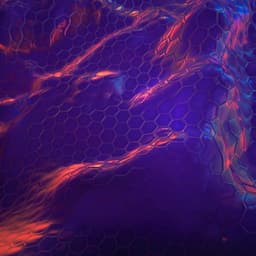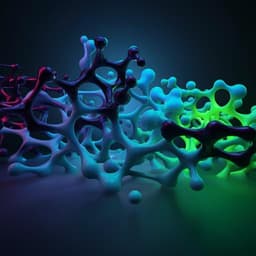
Physics
Carrier transport theory for twisted bilayer graphene in the metallic regime
G. Sharma, I. Yudhistira, et al.
This groundbreaking research by Gargee Sharma and team delves into phonon-dominated transport in twisted bilayer graphene, shedding light on its unique resistivity signatures. The study provides a robust theoretical framework that aligns closely with experimental observations, challenging existing dissipation mechanisms and paving the way for future exploration.
~3 min • Beginner • English
Introduction
Twisted bilayer graphene (tBG) near the magic angle hosts superconductivity and correlated insulating states, sparking debate about the underlying mechanisms. Moiré superlattices formed by small twist angles reduce Fermi velocity and bandwidth, enhancing interaction effects. Continuum models and ab initio studies predicted magic angles where the Fermi velocity is strongly suppressed, with lattice relaxation stabilizing only the largest magic angle near 1.06 degrees. The bandwidth reduction is tied to van Hove singularities (VHS) near the moiré Brillouin zone edges. The authors address carrier transport in the metallic regime of tBG, focusing on explaining linear-in-temperature resistivity and high-temperature saturation seen experimentally, and on distinguishing phonon-limited transport from proposed Planckian dissipation. They introduce a critical twist angle (~1.15 degrees) where the electronic Fermi velocity equals the acoustic phonon velocity and predict dramatic resistivity dips unrelated to superconductivity or Mott insulation. The study aims to develop a rigorous electron-phonon transport theory including interband processes, dynamical screening, and non-Dirac bandstructure effects, and to compare quantitatively with experiments to determine the dominant scattering mechanism.
Literature Review
Foundational work predicted moiré bands and magic angles in tBG, with later studies emphasizing lattice relaxation effects that stabilize a single primary magic angle. Experiments have observed VHS and signatures of strong correlations. Competing explanations for metallic transport include phonon scattering and Planckian dissipation associated with strange metal behavior. Prior transport theory in monolayer graphene treated intraband acoustic phonon scattering within a Dirac model and often neglected interband processes and dynamical screening, assumptions that can fail near magic angle where vF is small and the density of states is large. Earlier theoretical work predicted that gauge (off-diagonal) acoustic phonons dominate tBG resistivity over a wide experimental window, with charged impurities dominating only at very low temperatures and densities. Two experimental transport studies (MIT and a UCSB–Columbia collaboration) reported large linear-in-T resistivity and high-T saturation; one argued for Planckian dissipation, while the other favored phonon-dominated transport. The present study situates itself within this debate, extending the electron-phonon framework to include interband scattering, full finite-temperature dynamical screening in RPA, and a two-band model to capture VHS, and benchmarks against the Planckian phenomenology.
Methodology
The authors develop a Boltzmann transport theory for tBG resistivity dominated by acoustic electron-phonon scattering with several key extensions beyond monolayer graphene treatments: (1) inclusion of both intraband (vF > cph) and interband (vF < cph) processes, with the latter becoming crucial near magic angle; (2) full finite-temperature, finite-frequency dynamical screening of the electron-phonon matrix elements within RPA by evaluating the polarizability bubble Π(q, ω) and dielectric function ε(q, ω); (3) explicit separation of scalar (deformation potential) and gauge (off-diagonal) phonon couplings, showing gauge phonons dominate and are less screened; (4) going beyond the linear Dirac approximation by employing an effective two-band Hamiltonian that captures the van Hove singularity and the relation between bandwidth and vF.
- Electronic structure: Use continuum-model-derived parameters with and without lattice relaxation (two relaxation models) to obtain the renormalized Fermi velocity as a function of twist angle. For transport at higher energies, adopt an effective two-band Hamiltonian that reproduces the proximity to VHS and relates bandwidth (2εVHS) to vF.
- Screening: Compute Π(q, ω; T) semi-analytically to obtain ε(q, ω) and screen the electron-phonon couplings dynamically, verifying that static screening is a better approximation than leaving the deformation potential unscreened. Gauge phonon contributions remain dominant at low twist angles.
- Scattering: Evaluate electron-phonon scattering probabilities for TA/LA modes including absorption and emission, within an isotropic approximation for momentum-transport cross sections and restricting to intravalley processes. Derive interband and intraband scattering rates and their temperature and density dependences, identifying distinct regimes controlled by TBG (Bloch–Grüneisen temperature) and TF (Fermi temperature).
- Transport: Solve the Boltzmann equation in the relaxation time approximation with an angular ansatz for the non-equilibrium distribution to obtain τk, then compute resistivity by appropriate thermal averaging over the density of states and velocities. At low temperatures and densities, include charged impurity scattering and inhomogeneity via effective medium theory to capture the crossover from impurity-dominated to phonon-dominated transport.
- Planckian comparison: Implement a phenomenological Planckian model with resistivity proportional to kBT with strength C and compute its behavior within both Dirac and two-band approximations, extracting predicted density and temperature dependences and saturation values.
- Fitting and validation: Fit experimental resistivity data over temperature, density, and twist angle from multiple devices to both the electron-phonon theory (parameters: vF, gauge coupling strength) and the Planckian model (parameters: vF, C). Compare extracted parameters with theoretical expectations and assess consistency across datasets.
Key Findings
- Phonon-dominated transport: The extended electron-phonon theory quantitatively reproduces experimental resistivity in tBG over wide temperature and density ranges, including weak density dependence, linear-in-T behavior at low to intermediate temperatures, and high-temperature saturation.
- Interband vs intraband regimes: A critical twist angle near 1.15 degrees (where vF equals the acoustic phonon velocity) separates interband (vF < cph) and intraband (vF > cph) scattering. In the interband regime, resistivity becomes linear in T for temperatures well below the Bloch–Grüneisen temperature; the relevant scale is TF rather than TBG. This explains the persistence of linear-in-T resistivity below TBG seen experimentally without invoking non-Fermi-liquid behavior.
- Sharp resistivity dips: At vF = cph the phonon resistivity vanishes, producing sharp dips that can span several orders of magnitude. Near each magic angle there should be three prominent dips (two from vF = cph crossings and one at the magic angle), robust to lattice relaxation modeling.
- High-temperature saturation: In the phonon theory, the saturation of resistivity at high T is set by the electronic bandwidth (2εVHS). Accurately capturing this requires going beyond the Dirac model to include VHS via a two-band Hamiltonian.
- Gauge phonon dominance: Dynamical screening analyses show scalar (deformation potential) coupling is strongly screened while gauge (off-diagonal) coupling is enhanced by the moiré geometry and dominates transport; only the antisymmetric gauge mode survives at low twist angles.
- Impurity crossover at low T: Charged impurity scattering dominates at very low temperatures (below roughly 20 K) and low carrier densities (below about 1×10^11 cm^-2), producing a non-monotonic temperature dependence that crosses over to phonon-dominated linear-in-T behavior at higher T.
- Planckian model inconsistencies: Although the Planckian phenomenology can mimic linear-in-T at low T and saturation at high T, it predicts a much stronger carrier-density dependence than observed, yields saturation values independent of the bandwidth (contrary to experiment), requires Planckian strengths C often greater than 1 (violating the bound), and produces twist-angle-dependent vF values inconsistent with continuum-theory expectations. Extracted scattering times also contradict Planckian assumptions.
- Parameter extraction: Fits to electron-phonon theory yield Fermi velocities consistent with continuum models and gauge-field coupling strengths of order 1–9 eV, consistent with monolayer graphene benchmarks.
Discussion
The results demonstrate that conventional electron-phonon scattering—when treated with interband processes, proper dynamical screening, and realistic bandstructure beyond Dirac—accounts for the hallmark transport features of metallic tBG near magic angles. Linear-in-temperature resistivity below TBG arises naturally from interband scattering when vF < cph, resolving the experimental puzzle without invoking strange-metal Planckian dissipation. The high-temperature saturation being set by the VHS energy links transport directly to the moiré-band bandwidth, providing a clear experimental handle to probe bandstructure via transport. The identification of a critical angle where vF equals cph explains dramatic, angle-sensitive changes in resistivity and predicts multiple sharp dips near magic angles that are unrelated to superconductivity or correlation-driven insulating states. The dominance of gauge phonons, enhanced by the moiré geometry and weakly screened, unifies the temperature and density trends and clarifies why the phonon crossover occurs at much lower temperatures in tBG than in monolayer graphene. Comprehensive comparisons with multiple datasets show the Planckian picture is not the controlling mechanism in this metallic regime, as it fails key quantitative tests. Overall, the theory provides a coherent framework that connects twist-angle-dependent bandstructure, phonon modes, and transport observables.
Conclusion
This work establishes a rigorous, quantitatively accurate theory of phonon-limited transport in twisted bilayer graphene across the metallic regime. By incorporating interband scattering, finite-temperature dynamical screening, and a two-band model capturing the van Hove singularity, the theory explains linear-in-T resistivity well below the Bloch–Grüneisen temperature and the high-T saturation governed by the bandwidth. It predicts a critical angle near 1.15 degrees where phonon resistivity vanishes and multiple sharp resistivity dips near each magic angle, providing concrete, testable signatures. Comparative analysis rules out Planckian dissipation as the dominant transport mechanism in this regime. Future work could probe the predicted resistivity dips versus twist angle to infer lattice relaxation effects, map the bandwidth-controlled saturation across devices, and explore how these transport insights interface with nearby correlated insulating and superconducting phases, including the role of enhanced collective modes such as plasmons.
Limitations
The transport calculations adopt an isotropic approximation for momentum-transport cross sections and restrict to intravalley acoustic phonon scattering, which may omit anisotropies or intervalley processes in some regimes. The effective two-band Hamiltonian imposes a specific relation between bandwidth and Fermi velocity that, while capturing key physics, is model dependent. Screening is treated within RPA; beyond-RPA effects are not included. Lattice relaxation is incorporated via two specific relaxation models, introducing quantitative uncertainties in the precise positions of magic and critical angles. Parameter extraction relies on fitting experimental datasets and assumes homogeneity aside from effective-medium treatment of disorder at low temperatures.
Related Publications
Explore these studies to deepen your understanding of the subject.







